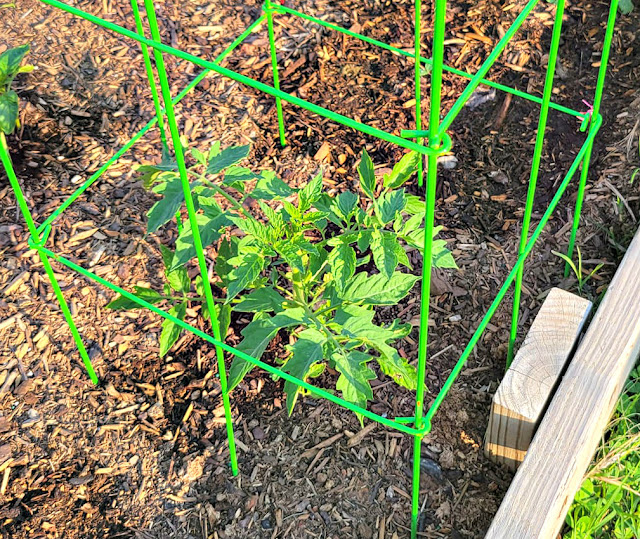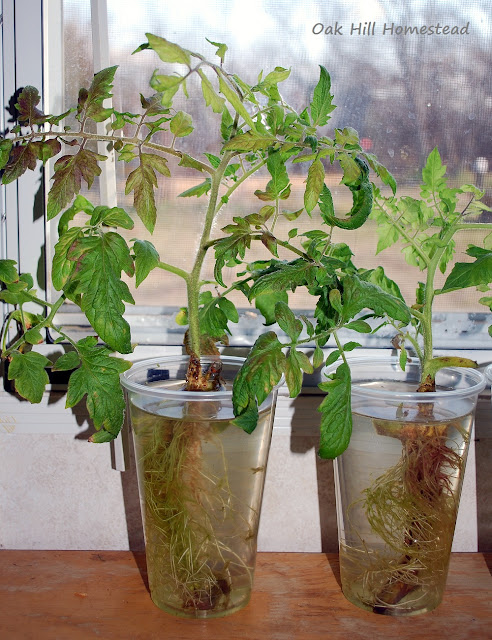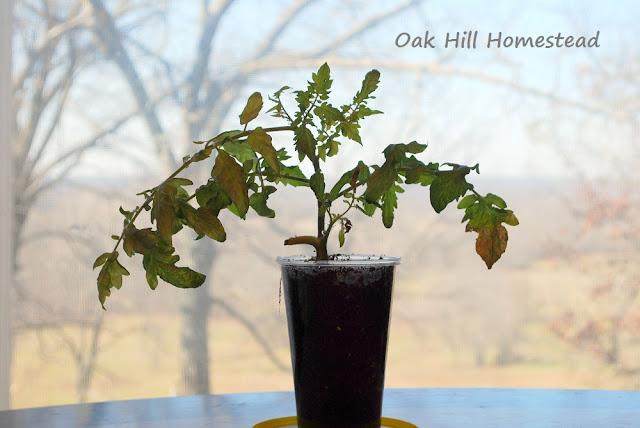Learn the secrets and the steps you can take to protect your tomato plants in winter, get a head start on next year's tomato garden and perhaps even harvest fresh, homegrown tomatoes in winter.
When the chilly winter winds start blowing, most gardeners bid farewell to their tomato plants after the first fall frost. But you don't have to!
What to do with tomato plants in winter
Tomato plants are actually perennials and are native to Central and South America, where the temperatures are warm-to-hot all year round.
The plants require temperatures between 55°F and 85°F in order to thrive. [Source] They'll die completely when the low temperature is below freezing.
Tomato plants are considered "frost sensitive" because they cannot survive a frost without protection.
But there are a few ways we can provide protection and keep tomato plants alive in the winter!
In this article we'll explore using a greenhouse, moving tomato plants indoors, and overwintering tomato cuttings.
Do tomato plants regrow each year?
Plants that survive winter and regrow in the spring are called "perennials," and plants that die in the winter are "annuals."
In most areas of the US, we grow tomatoes as annuals rather than perennials. So you'd have to plant tomato seeds every spring (or buy starter plants to transplant into your garden).
Volunteer tomato plants
While tomato plants don't actually "regrow" each year - in other words, they don't regrow from the roots - you might have some volunteer plants grow in the spring if you grew tomatoes last year.
Volunteers are plants that grow spontaneously from seeds that fell to the ground the year before. Usually this happens because:
- A ripe tomato hid from you and fell to the ground, where it rotted and left its seeds
- You tossed a tomato in your compost pile, where it rotted and the seeds survived and sprouted in spring.
- Your dog (ok, my dog!) stole a tomato and dropped it somewhere else in your yard, where it rotted and left its seeds.
Of course, this is how tomatoes (and other annual plants) reproduce in the wild: the fruit falls to the ground, rots away to nothing, and leaves its seeds that sprout in spring when the conditions are right. It happens in your garden too!
Volunteers may or may not produce tomatoes that are like the ones you planted the year before, though.
If you grew an heirloom variety, they should produce the same fruit. If you grew a hybrid variety last year, this year's volunteer tomatoes will probably look and taste quite different.
Hybrids are developed from two different kinds of tomatoes, and the next generation will probably take after one or the other of its parents.
If you'd like, you can transplant those volunteer plants to a better spot in your garden and let them grow. Even second generation hybrid tomato plants can be tasty!
For more information about heirloom and hybrid plants you can read "Why You Should Grow Heirloom Seeds," and you'll find definitions of many of the terms used in this article in "Common Garden Terms and Phrases for Beginning Gardeners" here.
What to do with the green tomatoes that are still on your tomato vines
Chances are that when it gets cold, you'll still have a bunch of green tomatoes on your plants. If so, you can find out what to do with them in this article: What to Do With Green Tomatoes.
You'll find several options. Don't let them go to waste, or toss them on the compost pile - use them!
Overwintering tomatoes
Can you overwinter tomato plants?
Yes, there are several ways that you can keep your tomatoes alive over the winter. Some of these ways are easier than others, and some (like a greenhouse) are quite a bit more expensive!
But first, what is your goal?
What is your goal in overwintering tomato plants?
Do you want to keep your tomato plants alive and move them back outdoors in spring, to get a head start on next year's garden? Or do you want fresh tomatoes during the winter?
The answer will help you decide which of these methods to use to keep your tomato plants alive in the winter.
First, there are two types of tomato plants: determinate and indeterminate.
Determinate tomato plants grow to a certain size, produce a large amount of tomatoes all at once, and then they die.
This type of tomato plant is perfect for gardeners who want to can spaghetti sauce, for instance. Canners want a large crop all at once.
Indeterminate tomato plants continue to grow all season long and produce tomatoes throughout the season. This type is loved by folks who want fresh tomatoes for salads, sandwiches and fresh eating all summer long.
If you want to keep your tomato plant alive over the winter so you can extend your harvest and move the plant back outside in the spring, indeterminate tomato types are the kind you want.
There are several varieties of "micro tomatoes" and "mini tomatoes" that can be grown indoors on a very sunny windowsill. These are determinate varieties. If your goal is to have fresh tomatoes in winter, these might be what you're looking for, especially if you don't have a lot of space.
Micro and mini refer to the plant size, but the fruit are usually cherry tomato size, not large.
1. Overwintering tomato plants in a greenhouse
The most expensive way to keep tomato plants alive in winter is to move them into a greenhouse.
A greenhouse has the ability to heat the air inside, to control the temperature and ventilation, and to provide a great deal of natural sunlight.
The heat in a greenhouse might be automated (controlled by a thermostat), or it might be manual, which requires the owner to keep an eye on the temperature and turn on a heater when needed.
Structures such as high tunnels, low tunnels and so on aren't greenhouses unless there is a heating system of some kind, and a small "backyard greenhouse" isn't actually a greenhouse unless you put a heater inside.
I have friends with hoop houses here in Oklahoma, but a hoop house isn't warm enough to keep a tomato plant alive in the depths of winter, even here in Oklahoma, zone 7b.
If you have a true greenhouse, I'm jealous!
2. Growing tomatoes indoors in winter
If you have the space in your home, you can move your tomato plants indoors.
Be aware that even one tomato plant will require quite a bit of space, and will need to be in a large pot or container. A five-gallon bucket is a good size.
The container will need drainage holes, and you'll need to protect your floors and furniture from water damage.
The plant will also need a lot of sunlight. Tomato plants need at least six hours of direct sunlight daily - eight hours is better - in order to thrive and perhaps produce fresh tomatoes during the winter.
"Direct sunlight" comes in a window and shines directly on the plant. This can be hard to achieve in many homes, even those with a large window.
Less sunlight will most likely keep your plant alive though, even if it doesn't produce fruit. In fact, if "keeping it alive" is your goal, you can even trim the plant occasionally so it won't take over your house!
You'll also need to provide support for a very large tomato plant.
If your window doesn't provide enough sunlight, you can supplement with grow lights.
When it's time to move your tomato plants back outside in the spring, be sure to follow the suggestions below to help them adapt.
3. Overwintering tomato cuttings
This is the method I use. All you need is a sunny windowsill and cuttings from a tomato plant.
My goal is simply to keep my cuttings alive and plant them in the spring, to get a headstart on my garden.
But there are other benefits as well.
If you're growing a particular variety of hybrid that you love, taking cuttings will give you plants that are the same as the parent plant. The same hybrid variety with the same fruit.
If you're growing a variety that is hard to find, either the seeds or started plants, rooting cuttings will give you more of those hard-to-find plants.
And you'll have plants ready to go in the ground when the weather is warm enough in late spring, after all danger of frost has passed, without having to go buy them.
You almost can't fail, although some varieties of tomato plants will root more easily and successfully than others.
It's super easy to take cuttings of tomato plants and root them in water.
My tomato cuttings are simply stuck in a glass or jar of water and set on my east-facing kitchen windowsill - which is also the only window in our house that the cats can't access. They like to eat plants.
After the cuttings develop roots, which happens in just a few days, they can be planted in soil or left in their jars.
They will continue to grow in water, but they will get very leggy and outgrow their jar or glass of water long before spring arrives.
I'm kind of crazy. When my cuttings grow too tall, I even take cuttings of the plants that are growing in water on my windowsill and root them in water.
Some winters I do this over and over and have healthy plants to put in my garden as soon as it's warm enough in spring.
Take cuttings before the first frost
I take cuttings of my tomato plants before the first frost and stick them in a jar of water.
Some varieties of tomato plants will root in water in about a week, others take a bit longer.
As the weeks go by, the roots kind of go crazy! After awhile you'll have a mat of roots in the water.
Tomato plants are heavy drinkers, so you'll need to keep an eye on the water level in the jars and top them off when the water gets a little low.
Since we have "rural water" here in Oklahoma, which is lake or municipal well water that is treated and piped to homes, I fill a glass of water and let it stand without a lid for at least 24 hours before using it.
This way, any chlorine in the water dissipates into the air before I add the water to the plants' jars.
If you have well water you may not need to do this, but if you have city water I recommend that you let the chlorine evaporate.
Your cuttings will grow best in a sunny windowsill.
My experience with overwintering cuttings - a spring update
I've been overwintering tomato cuttings since 2012.
That first fall, I took cuttings of the Bradley tomatoes I was growing before the first frost warning. Bradley is an heirloom variety.
I also took cuttings from the Early Girl plants, which are a hybrid variety.
Although I changed the water weekly, I think the cuttings would have also benefitted from some compost tea or other diluted liquid fertilizer during the winter months.
Early in January I lost the Bradley cuttings. I think they just ran out of energy and sustenance and they gave up.
However, the Early Girl plants did well all winter. At about the end of February their dark green leaves began to lighten. They probably needed some supplementing with fertilizer, since water doesn't have the nutrients that plants need, like soil does.
One of those cuttings grew really tall and even bloomed once. I pinched the flower off, not wanting the plant to put energy into producing fruit.
I cut these plants in half and stuck the tops into another glass of water so that they too could root.
How to pot up your overwintering tomato cuttings
If you choose to plant your rooted cuttings in soil instead of growing them in water, here's how to put them up.
Plastic cups work well as pots, They are inexpensive and you can write on them with a Sharpie so you'll remember what varieties you're growing.
Use a sharp knife to cut a hole or two in the bottom of the cup.
Use well-draining potting soil. Tomato plants hate having "wet feet" and soggy soil.
Put an inch or so of potting soil in the bottom of the cup. You'll want to plant your cuttings deeply so don't put too much soil on the bottom.
Hold the rooted cutting inside the cup, while adding potting soil around the stem and roots. You can use a spoon to add the soil around the roots if you wish.
Spread the roots out in the potting soil if you can, but remember, tomato plants are really resilient and they'll adapt!.
When the cup is full, tamp the soil down a bit or compact it with your fingers, then add more to bring the level back up to the top.
The plants will grow new roots all along their buried stems.
Water the potted cuttings well and set the cups in the sink to drain. Remember that the plants have been living in water all winter, so they will need plenty of water at first while they adapt to their new environment.
But they also don't like having wet roots, so be sure the soil can drain easily.
If needed, you can transplant these plants into larger pots before spring.
You can plant your tomatoes in your garden after all danger of frost has passed in the spring.
Tomato plants won't survive a frost, so don't be in too much of a hurry to plant them out. Tomatoes don't really take off in the garden until the weather warms up anyway, so be patient.
Even though you can't plant them outside any earlier than seed-started transplants, you'll have larger plants when it's time.
I'm sure you've seen those big tomato plants for sale at the garden center in spring, the ones that are a foot or two high and maybe even have a stake to support them in their big pots. They're often priced at $10 - $25 each.
Looky there, you've saved yourself as much as $25 by growing your own!
Moving your overwintered tomato plants outside in the spring
Whether you overwintered your tomato plants indoors or in a greenhouse, or kept cuttings indoors on a windowsill, you'll need to harden off your plants before moving them outdoors in spring.
Harden your tomato plants off before planting in the ground by setting them outside on nice days in a shady, protected spot. Bring them back inside at night.
Gradually increase the time they spend outside, and their exposure to direct sunlight.
Pinch off any flowers on your plants until they're ready to stay outside permanently.
You now have good-sized transplants to plant out in your garden.
Fragile seedlings are prone to fungus and attractive to cutworms, but you've skipped that stage and have large, healthy transplants that a garden center would sell for a high price. Congratulations!
You should save tomato seeds too
Because I'm a cautious sort of person, and don't like putting all my eggs in one basket so to speak, I also save seeds from my tomato plants each summer.
I like a wide array of tomato varieties, and seeds for some of them can be hard to find. I like having a back-up plan so I take cuttings in the fall to keep over the winter, but I also save seeds to plant in spring.
Here's how to store seeds for the best germination, whether you're storing seeds from your own plants or a seed packet you purchased.
(By the way, this post was originally written in 2012,
but was revised, rewritten and updated in October 2023.)
Keeping records
If you grow more than one variety of tomatoes and save cuttings from them all, you might want to keep a record of what varieties you're overwintering.
Even if you're only saving cuttings from one variety, keep records of when you took the cuttings and how they did over the winter.
Sharpie pens will write on glass jars and on plastic cups to help you keep track of which plants are which variety.
Here is some of the information you should record:
- Are you growing heirloom or hybrid varieties?
- Are they determinate or indeterminate plants? (Just FYI, I have not tried overwintering determinate tomato plants.)
- What date did you take the cuttings?
- Did you feed the cuttings over the winter? What kind of fertilizer did you use? (I recommend compost tea or diluted fish emulsion fertilizer.)
Some varieties will grow from cuttings better than others, and the only way to find out which works best is to experiment and keep track of your results.
I kept notes each year, and shared the results (well, the first five years' worth of results) with you in this post: over-wintering tomato plants, successes and failures. Find out what I learned the hard way!
For more gardening and simple-living posts subscribe to The Acorn, Oak Hill Homestead's weekly-ish newsletter, and join me on Facebook, Instagram and Pinterest. I'd love to see you there!
~~~~~
Facebook | Instagram | Pinterest | Subscribe

















.jpg)









